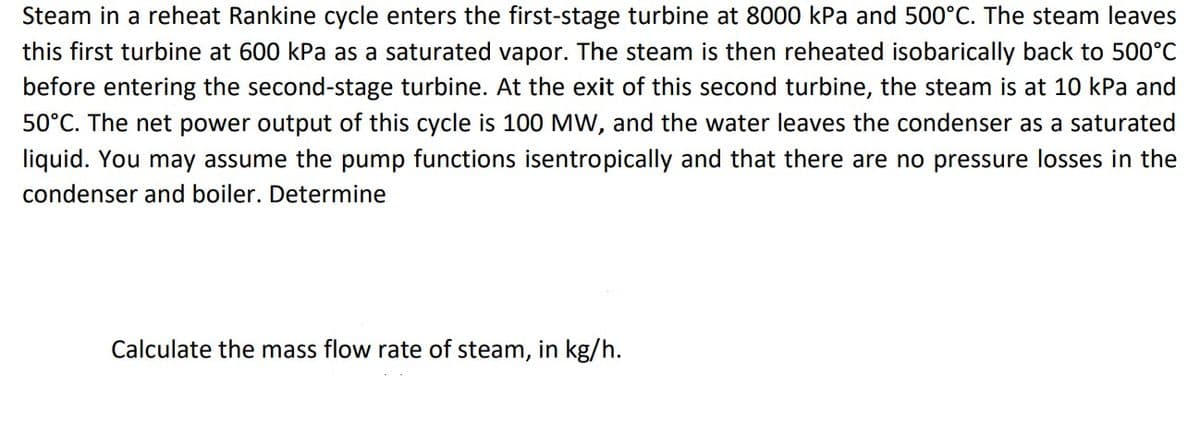Steam in a reheat Rankine cycle enters the first-stage turbine at 8000 kPa and 500°C. The steam leaves this first turbine at 600 kPa as a saturated vapor. The steam is then reheated isobarically back to 500°C before entering the second-stage turbine. At the exit of this second turbine, the steam is at 10 kPa and 50°C. The net power output of this cycle is 100 MW, and the water leaves the condenser as a saturated liquid. You may assume the pump functions isentropically and that there are no pressure losses in the condenser and boiler. Determine Calculate the mass flow rate of steam, in kg/h.
Steam in a reheat Rankine cycle enters the first-stage turbine at 8000 kPa and 500°C. The steam leaves this first turbine at 600 kPa as a saturated vapor. The steam is then reheated isobarically back to 500°C before entering the second-stage turbine. At the exit of this second turbine, the steam is at 10 kPa and 50°C. The net power output of this cycle is 100 MW, and the water leaves the condenser as a saturated liquid. You may assume the pump functions isentropically and that there are no pressure losses in the condenser and boiler. Determine Calculate the mass flow rate of steam, in kg/h.
Elements Of Electromagnetics
7th Edition
ISBN:9780190698614
Author:Sadiku, Matthew N. O.
Publisher:Sadiku, Matthew N. O.
ChapterMA: Math Assessment
Section: Chapter Questions
Problem 1.1MA
Related questions
Question

Transcribed Image Text:Steam in a reheat Rankine cycle enters the first-stage turbine at 8000 kPa and 500°C. The steam leaves
this first turbine at 600 kPa as a saturated vapor. The steam is then reheated isobarically back to 500°C
before entering the second-stage turbine. At the exit of this second turbine, the steam is at 10 kPa and
50°C. The net power output of this cycle is 100 MW, and the water leaves the condenser as a saturated
liquid. You may assume the pump functions isentropically and that there are no pressure losses in the
condenser and boiler. Determine
Calculate the mass flow rate of steam, in kg/h.
Expert Solution
This question has been solved!
Explore an expertly crafted, step-by-step solution for a thorough understanding of key concepts.
This is a popular solution!
Trending now
This is a popular solution!
Step by step
Solved in 5 steps with 5 images

Knowledge Booster
Learn more about
Need a deep-dive on the concept behind this application? Look no further. Learn more about this topic, mechanical-engineering and related others by exploring similar questions and additional content below.Recommended textbooks for you

Elements Of Electromagnetics
Mechanical Engineering
ISBN:
9780190698614
Author:
Sadiku, Matthew N. O.
Publisher:
Oxford University Press

Mechanics of Materials (10th Edition)
Mechanical Engineering
ISBN:
9780134319650
Author:
Russell C. Hibbeler
Publisher:
PEARSON

Thermodynamics: An Engineering Approach
Mechanical Engineering
ISBN:
9781259822674
Author:
Yunus A. Cengel Dr., Michael A. Boles
Publisher:
McGraw-Hill Education

Elements Of Electromagnetics
Mechanical Engineering
ISBN:
9780190698614
Author:
Sadiku, Matthew N. O.
Publisher:
Oxford University Press

Mechanics of Materials (10th Edition)
Mechanical Engineering
ISBN:
9780134319650
Author:
Russell C. Hibbeler
Publisher:
PEARSON

Thermodynamics: An Engineering Approach
Mechanical Engineering
ISBN:
9781259822674
Author:
Yunus A. Cengel Dr., Michael A. Boles
Publisher:
McGraw-Hill Education

Control Systems Engineering
Mechanical Engineering
ISBN:
9781118170519
Author:
Norman S. Nise
Publisher:
WILEY

Mechanics of Materials (MindTap Course List)
Mechanical Engineering
ISBN:
9781337093347
Author:
Barry J. Goodno, James M. Gere
Publisher:
Cengage Learning

Engineering Mechanics: Statics
Mechanical Engineering
ISBN:
9781118807330
Author:
James L. Meriam, L. G. Kraige, J. N. Bolton
Publisher:
WILEY